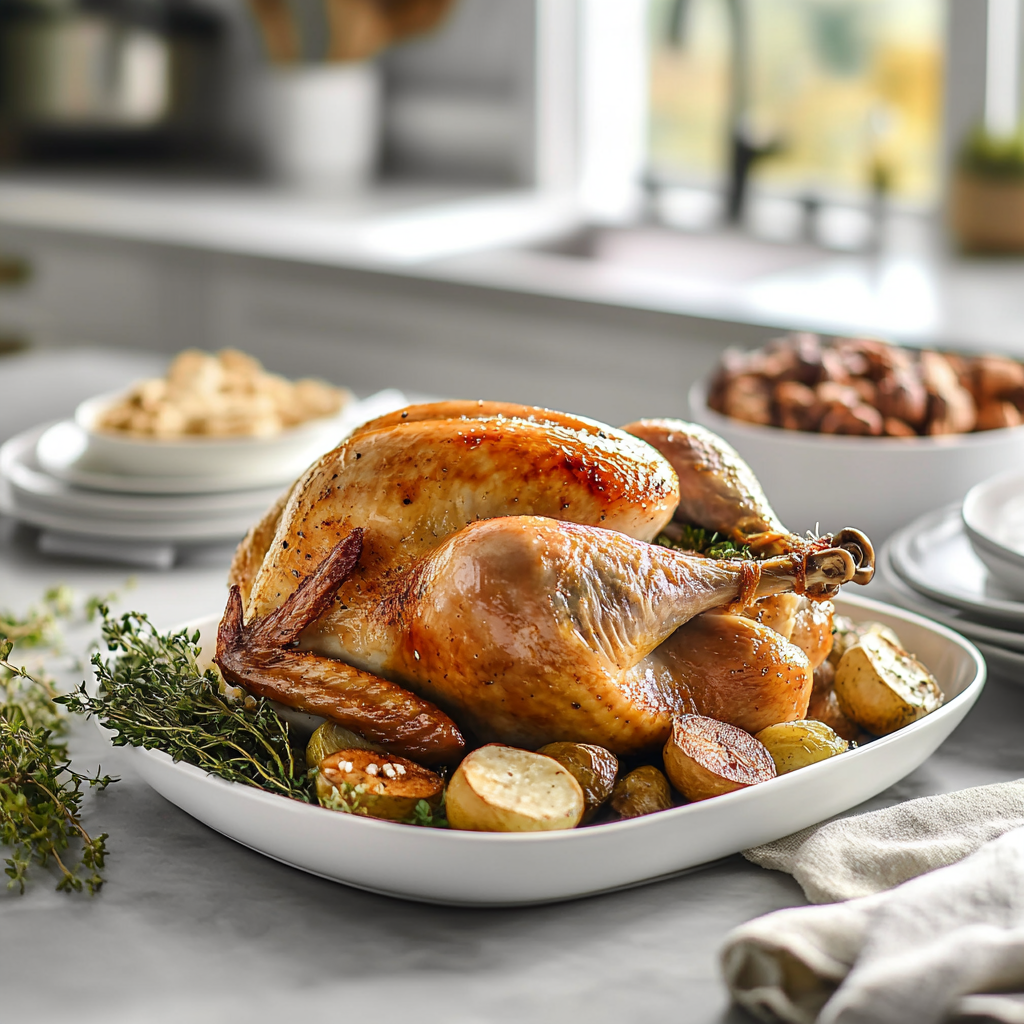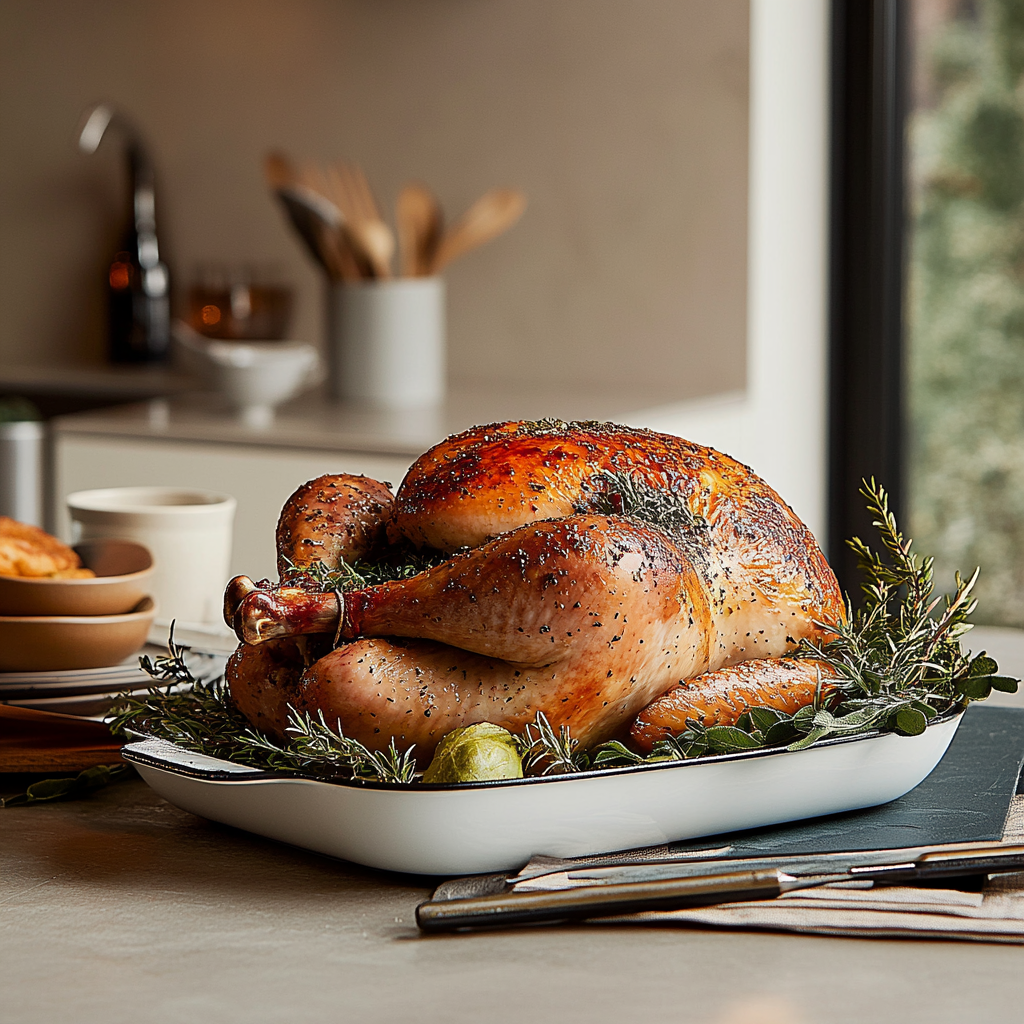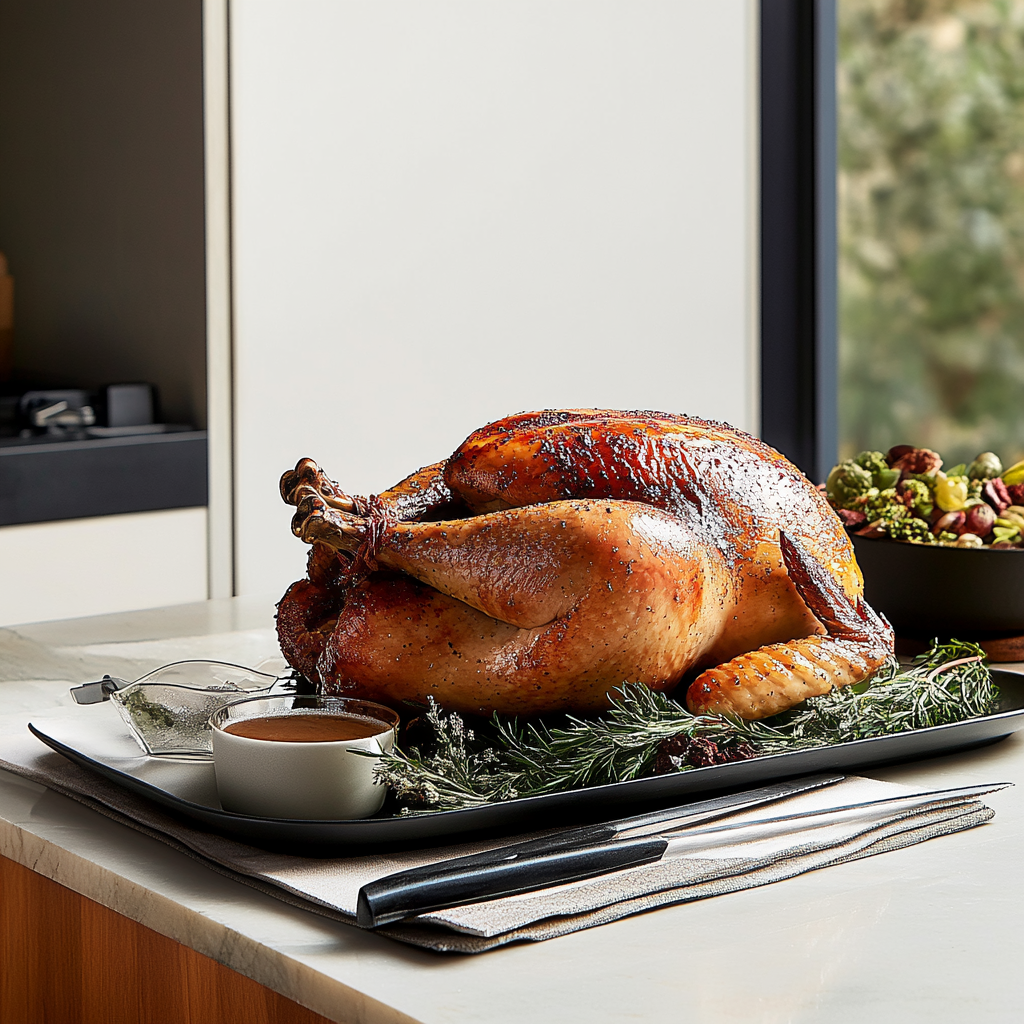Introduction and Quick Summary
Thanksgiving is a cherished time of year filled with family, friends, and the delightful aroma of a perfectly roasted turkey wafting through the kitchen. The heart of any Thanksgiving feast is undoubtedly the Thanksgiving turkey recipe that brings everyone together around the dining table. This article will guide you through crafting a succulent turkey that not only looks stunning but also tastes divine. Whether you’re a seasoned chef or a novice cook, this detailed recipe will ensure that your holiday gathering is unforgettable.
The secret to a delicious Thanksgiving turkey lies in its seasoning and cooking method. From brining to roasting techniques, every step plays a crucial role in achieving that juicy meat and crispy skin we all crave. Additionally, serving this classic dish with traditional sides like stuffing and cranberry sauce elevates the meal to new heights. With our user-friendly instructions and tips for success, you can impress your guests with your culinary skills while creating lasting memories around the table.
In this article, we’ll cover the essential ingredients needed for your Thanksgiving turkey recipe and provide step-by-step instructions to help you prepare it flawlessly. We’ll also share serving suggestions and storage tips to ensure every bite is as delightful as the first. Let’s dive into making this year’s Thanksgiving celebration one for the books!
Main Ingredients
Understanding the core ingredients is essential for crafting an exceptional Thanksgiving turkey recipe. Each ingredient contributes to the overall flavor and texture of the dish. Below are the key components you’ll need:
Turkey
Selecting the right turkey is vital for your Thanksgiving dinner. Aim for a fresh or thawed turkey weighing between 12 to 20 pounds if you’re serving a group of eight to ten people. A larger bird allows for more leftovers, which are often just as enjoyable as the main meal! Ensure you remove any giblets from inside the cavity before cooking.
Butter
Butter adds richness and moisture to your turkey while enhancing its flavor profile. Use unsalted butter so you can control the saltiness in your dish better. You’ll need about one cup of softened butter for basting throughout the cooking process.
Herbs
Fresh herbs such as rosemary, thyme, sage, and parsley play an essential role in elevating your turkey’s flavor. These aromatic herbs add depth and complexity to each bite. You will require about two tablespoons each of chopped fresh herbs mixed into your butter mixture.
Garlic
Garlic infuses savory notes into your Thanksgiving turkey recipe. Use whole cloves or minced garlic to enhance flavors further during roasting. Typically, four to six cloves should suffice; however, feel free to adjust according to your preference.
Broth
Using broth instead of water when basting or cooking helps keep your turkey moist while adding additional flavor. Opt for low-sodium chicken or vegetable broth—about four cups should work well.
Seasonings
The right blend of seasonings will bring out all those delicious flavors in your turkey recipe. Common seasonings include salt, pepper, paprika, onion powder, and ground sage—each contributing its unique taste profile.

How to Prepare Thanksgiving Turkey Recipe
Preparing your Thanksgiving turkey requires attention to detail but is ultimately rewarding when done correctly. Follow these carefully crafted steps:
Step 1: Brine Your Turkey (Optional)
Brining enhances moisture retention during roasting while infusing flavor deep into the meat—a crucial step! Begin by dissolving salt (one cup kosher salt) in four quarts of water in a large container or brining bag (you can add sugar if desired). Submerge your cleaned bird fully in this solution and refrigerate it overnight or at least twelve hours before cooking.
Step 2: Preheat Your Oven
Preheating ensures even cooking throughout your bird while creating that desired crispy skin on top! Set your oven temperature between 325°F (165°C) to 350°F (175°C).
Step 3: Prepare Your Roasting Pan
Choose a sturdy roasting pan with high sides so juices don’t overflow during cooking! Place a rack inside it—this allows hot air circulation around every part of your bird—keeping it juicy on all sides.
Step 4: Season Your Turkey
Start by patting dry both outside and inside cavities using paper towels after removing from brine (if applicable). Generously rub softened butter all over its exterior plus under its skin; then season liberally with salt/pepper mixture along with fresh herbs/garlic paste prepared earlier!
Step 5: Roast Your Turkey
Place seasoned bird breast-side up on rack within preheated oven; roast according until internal temperature reaches at least 165°F (75°C), typically around fifteen minutes per pound! Baste every half hour using broth mixture prepared previously—this helps maintain moisture levels while browning skin beautifully!

Serving and Storing Tips
Properly serving and storing leftover Thanksgiving turkey ensures everyone enjoys this delectable main course long after dinner ends!
Serving Suggestions
When it’s time to serve up that beautiful bird at dinner table presentation matters just as much as taste! Carve slices directly from breast/thigh joints using sharp carving knife; arrange attractively on platter surrounded by favorite side dishes like stuffing/cranberry sauce; garnish with fresh herbs/fruit slices if desired too!
Storing Leftovers
To store leftover meat safely refrigerate within two hours post-meal; cut away excess fat/skin before wrapping tightly in plastic wrap/airtight containers—this keeps flavors intact & prevents spoilage! Consume within three days maximum; alternatively freeze untouched pieces wrapped securely until next occasion arises—frozen leftovers generally last up one year!
By following these guidelines closely you’ll create an unforgettable experience around table filled laughter/family bonding moments—all thanks incredible Thanksgiving Turkey Recipe shared here today! Enjoy every moment celebrating togetherness during festive season ahead!
Mistakes to Avoid
One common mistake when preparing a Thanksgiving turkey recipe is not properly thawing the bird. Many people underestimate the time it takes for a frozen turkey to defrost. Ideally, you should allow 24 hours of thawing time for every four to five pounds of turkey. If you fail to fully thaw your turkey, you risk uneven cooking, which can lead to dry meat or undercooked sections that pose a food safety risk.
Another frequent error is skipping the brining process. Brining your turkey enhances its flavor and keeps it moist during cooking. A simple saltwater mixture can work wonders, but many home cooks overlook this step. If you decide not to brine, consider using a flavorful marinade or injecting your turkey with a seasoned broth to enhance its taste.
Overcooking is also a significant issue that many encounter while following a Thanksgiving turkey recipe. It can be tempting to cook the turkey longer than necessary to ensure it’s done, but this often results in dry meat. Instead, use a meat thermometer to check for doneness. The internal temperature should reach 165°F in the thickest part of the breast and the innermost part of the thigh.
Lastly, neglecting to rest the turkey after cooking is a mistake that can ruin your meal. Resting allows juices to redistribute throughout the meat, making it juicier and easier to carve. Aim for at least 20-30 minutes of resting time before slicing into your turkey.
Tips and Tricks
To achieve a delicious Thanksgiving turkey recipe, start with high-quality ingredients. Selecting an organic or free-range turkey can significantly enhance flavor and texture. Fresh herbs and spices also elevate your dish; consider using rosemary, thyme, and garlic for aromatics that will infuse your bird with rich flavors.
Another essential tip is to prepare your stuffing separately rather than inside the turkey. Cooking stuffing inside can lead to uneven cooking and increase the risk of foodborne illnesses if it doesn’t reach safe temperatures quickly enough. Instead, bake it in a separate dish so both components cook evenly and safely.
Consider using a roasting pan with a rack for optimal air circulation around the turkey while it cooks. This method ensures even browning and reduces cooking time by allowing hot air to circulate beneath the bird. Additionally, basting occasionally with pan juices will help keep the skin crispy while maintaining moisture within.
Finally, don’t forget about presentation! A beautifully garnished turkey will impress your guests. Use fresh herbs, citrus fruits like oranges or lemons, and colorful vegetables around your platter for an eye-catching display that makes your Thanksgiving feast unforgettable.
Suggestions for Thanksgiving Turkey Recipe
When planning your Thanksgiving dinner, consider experimenting with flavors that complement traditional recipes yet add unique twists. For example, try incorporating maple syrup or apple cider into your marinade or glaze for added sweetness that contrasts beautifully with savory notes.
In terms of preparation methods, smoking or grilling your turkey can provide an exciting alternative to roasting in the oven. These methods impart distinct flavors and create tender meat that tantalizes taste buds. Be sure to adjust cooking times based on these techniques since they may differ from conventional roasting methods.
If you want something more contemporary, consider creating a stuffed turkey breast roll instead of cooking an entire bird. This approach allows you more control over cooking times and provides individual portions without sacrificing flavor or quality.
For those who seek convenience without compromising taste, consider utilizing pre-prepared options from local butcher shops or grocery stores known for quality meats. Many offer seasoned turkeys ready for roasting that still deliver on flavor while saving you valuable prep time during busy holiday preparations.

FAQs
What size turkey should I buy for Thanksgiving?
Choosing the right size turkey depends on how many guests you plan to serve at your Thanksgiving gathering. It’s generally recommended to allocate about one pound of uncooked turkey per person if you’re planning on having leftovers as well; this means an 18-pound bird would suffice for 12-15 guests comfortably. If you’re expecting larger gatherings or love leftovers, opting for slightly bigger sizes is beneficial!
How do I ensure my turkey stays moist?
To keep your Thanksgiving turkey recipe moist during cooking, consider brining it ahead of time or using an injection marinade filled with broth and seasonings before roasting. Additionally, avoid overcooking by checking internal temperatures regularly; ideally aiming for 165°F in various parts of the bird ensures juicy results!
Can I prepare my Thanksgiving turkey ahead of time?
Yes! You can prepare various components beforehand without losing quality! Consider brining or marinating up to two days prior while storing in refrigeration until it’s ready for roasting day-of! Soaking overnight in flavorful mixtures enhances taste while reducing stress on actual holiday prep!
How long should I let my turkey rest after cooking?
Resting is crucial once you’ve cooked your Thanksgiving bird! Allow at least 20-30 minutes before carving into it—this lets juices redistribute throughout all areas ensuring every slice stays flavorful without being dry!
What are some side dishes that pair well with roast turkey?
There are countless delicious sides perfect alongside roasted birds—classic favorites include mashed potatoes adorned with gravy alongside sweet cranberry sauce & stuffing made from bread soaked in broth! Other great options include green bean casseroles & roasted seasonal vegetables like Brussels sprouts!
Is there an alternative way of cooking my Thanksgiving Turkey?
Absolutely! While traditional roasting remains popular amongst families during holidays—smoking/grilling offers exciting alternatives too! These methods impart smoky flavors giving each bite uniqueness while keeping meats tender & juicy; don’t shy away from trying new techniques this year!
Conclusion
Successfully crafting a memorable Thanksgiving dinner centers around mastering key aspects of preparing the star dish: the Turkey itself! By avoiding common mistakes such as improper thawing or neglecting brining techniques leads towards achieving deliciousness meant at any gathering table setting!
Employing practical tips like utilizing high-quality ingredients & presenting beautifully garnished platters elevates overall experiences immensely! With suggestions like experimenting beyond typical roasts encourages creativity whilst satisfying diverse palates amidst family gatherings making lasting memories together!
Ultimately remember: resting appropriately post-cooking ensures juicy outcomes—the culmination of effort put forth leads towards enjoying festive meals filled with laughter surrounded by loved ones—making every bite worth cherishing through stunning recipes shared across generations!

